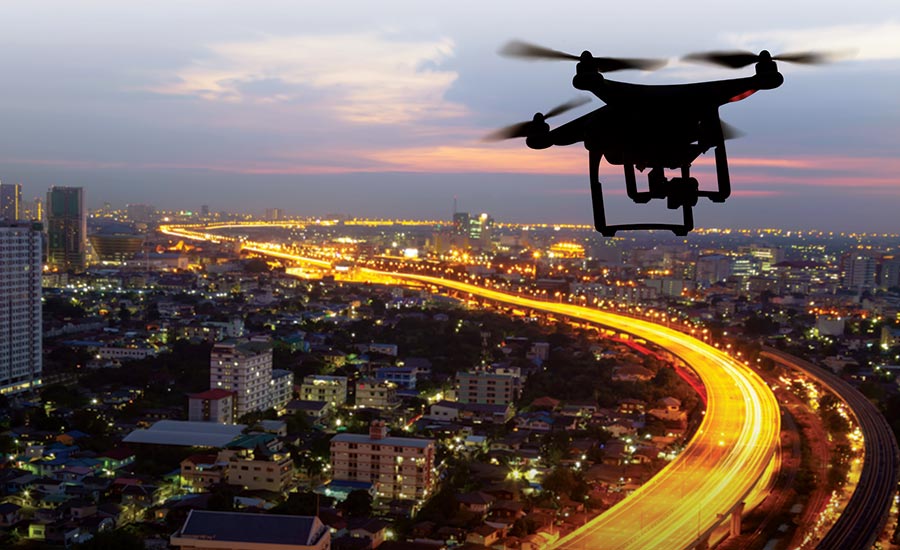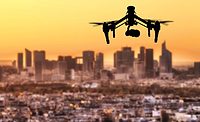Drones: A Security Tool, Threat and Challenge
Benefits, risks, challenges and advice for drones in enterprises in 2018.

The commercial use of unmanned aircraft systems (UAS), more commonly known as drones, has exploded over the last few years, and it’s clearly on a trajectory to continue. Its global market is currently worth $2 billion, and that number is estimated to skyrocket to $127 billion in 2020. The Federal Aviation Administration (FAA) predicts that commercial drones will jump from the 80,000 registered units in August 2017 to more than 420,000 units by 2021. There are certification programs sprouting up all around the country where you can become a certified drone operator. What does all of this mean for enterprise security?
How Drones Can Help
There are many ways drones can help enterprise security teams to manage their risk mitigation efforts more efficiently, safely and cost-effectively, including:
- Risk assessments: Enterprise security personnel can use drones to find gaps and vulnerabilities that wouldn’t normally be seen, thanks to a different point of view, says James A. Acevedo, president at Star River Incorporated. “Rather than seeing things in a 2D frame, you’re seeing things in a 3D frame, which really changes the dynamic of how you position your security countermeasures,” he says.
- Perimeter control and other security officer situations: Drones can help monitor perimeters, parking lots, prisons, college campuses, stadiums and other outdoor venues. Using a thermal imaging camera makes this possible at night as well.
- Inspections: Security teams can now inspect and monitor roofs and other high places from the ground with drones.
- Executive security: “If you have an executive protection team that’s operating in remote locations, they could potentially utilize a drone to do forward observation of routes and to identify any potential issues that are en route while they’re driving their primaries around,” Acevedo says.
- Securing remote assets: If you’re trying to secure hundreds of acres of land or animals out in the pasture, drones are a great way to watch for poachers or predators. They can check on machinery, pipelines, wind farms and other infrastructure in remote areas.
- Safety: A drone can usually get to a prison fight, an intruder and other potential problems faster than an officer can and assess the risk so personnel know better how to respond. Drones also have the capability to analyze images and use audio and video sensors to listen for gunfire, explosions and the like, says Ryan Hendricks, managing partner at Dronusphere. “They’re able to differentiate between gunfire and explosions so they can call the police or report to someone that there’s been an explosion at a power plant, for example,” he says.
- Emergency relief: Dozens of drones were authorized by the FAA to respond to Hurricanes Harvey, Maria and Irma, assessing damage and finding people who needed help. They’ve recently been used in the fires in southern California as well to gather data for emergency response treatment, says Hendricks. “They’re being used as security monitoring and sensing tools, everything from video to audio to infrared. They’re also being used to find people inside of collapsing buildings or earthquake victims,” he says.
- Cost savings: For many enterprises, implementing drones can mean big cost savings, notes Hendricks. For instance, if you want to monitor a power center or operational center, “without drones, you’re using everything from full-time security officers to cameras, and of course fencing, and maybe even helicopters if there’s an issue,” Hendricks says. “Drones can be set up to surveil the property continuously overnight. You can have three rotating drones that charge themselves, make a run around the perimeter and then hand off to the next drone. You can find drone applications that save money in almost every industry, or that allow you to do things you couldn’t do otherwise.”
Risks and Challenges of Drones
All of these potential benefits and advantages don’t come without their share of risks and challenges, especially when it comes to the complexities of enterprise security. Some of these include:
- Data theft: This is a huge issue, especially with the recent news that popular drone manufacturer D.J.I. may be sending sensitive data from its drones in the United States to China, says Acevedo. “There are literally thousands of these drones flying all over the U.S., being used in a variety of different landscapes, and all of that information is giving China access to information it would normally never be able to have access to,” he says. Drones are also just as vulnerable to hackers and security vulnerabilities as any other Internet of Things (IoT) device is, whether they’re in flight or not.
- Loss of control: This can happen either by someone hacking and taking control of the drone or from a system failure or frequency interference, says Allianz Global Corporate & Specialty’s “Rise of the Drones” report. AGCS predicts that frequency interference will be a big risk, since these incidents, and resulting injuries, have already occurred. The potential for a hacker to use the drone for malicious acts is there as well.
- Collisions: Perhaps the biggest safety threat from drones is potential collisions with airplanes. “Even birds can take down planes, but unlike a bird, the drone doesn’t get chewed up so easily by the engine,” says Hendricks. “These drones, because of the hardened materials on many of them and the velocity at which they move, can take down a passenger plane.” The most at-risk aircraft are ones that fly below 500 feet, like helicopters, agricultural planes and any aircraft that’s taking off or landing, says AGCS.
- Limited battery power: “Most of your commercial drones can fly for 30 minutes and that’s about it,” Hendricks says. “They’re building charging stations where the drone can basically sit down on a charging point and charge itself and take off again. There’s a whole industry of companies building chargers.”
- Untrained operators: “There aren’t enough trained drone operators to meet the demand right now,” says Hendricks. Additionally, you have to be certified by the FAA to fly a commercial drone, as well as pass Transportation Security Administration (TSA) vetting too. “A lot of people have a tendency to just go out and buy a drone and think they can fly it,” Acevedo says. “There’s a learning curve to flying these things.”
- Analyzing data and data transmission: Many drones don’t have a signal while they’re in flight, says Hendricks. “They don’t have Wi-Fi or cellular connections, so they have to have a lot of on-board processing and they may have to fly to an area where they have a signal and can send the data.” Another potential problem he sees for enterprises is not thinking far enough ahead as to how they’re going to analyze all that data.
- Liability: “When you utilize a tool, you’re responsible for what that tool does. Anyone operating an unmanned aerial system in a professional manner needs to have liability insurance,” Acevedo says. “The main reason is due to the complexity, cost and risk when it comes to operating these systems. It would be smart to not only insure the UAS, but also insure the pilot.” He notes that an operational risk assessment should be used so that you aren’t paying for millions of dollars in coverage when you’re just flying your drone around your farm.
- Legislation: Commercial drones must be under 55 lbs., kept in the operator’s line of sight and registered if they weigh .55 lbs. or more, according to FAA regulations. But global regulations as a whole are still in their infancy and have a long way to go to catch up with a market that’s fit to burst in its desire to expand. In mid-October 2017, commercial drone regulations hit another snag when the advisory group on regulating them couldn’t agree on tracking requirements for different types and sizes of drones.
- Expectations: Enterprise security leaders may want to jump on the drone bandwagon because it’s new, hot technology, but it’s important to know what you’re getting, as well as its limitations, says Acevedo. “Because this technology is so new, you have to be very cautious, and you need to have some serious, realistic expectations as to what you’re going to accomplish. Sometimes you think a drone can do something really great and ultimately, it’s not going to give you the data you need,” he says.
Points to Consider When Utilizing Drones
Still interested in utilizing drones in your enterprise security program? Here’s some advice:
- Do a risk assessment. You need to look at threats, vulnerabilities and consequences, as well as why you want to use drones, advises Acevedo. “You need to be sure you have a valid reason as to why and that it’s not just the cool factor.” Use the risk assessment to identify what you want to do and how you want to do it. Also take into consideration details like FAA approval to operate, licensure, insurance, operator training, manufacturer requirements and approval, who’s going to fly the drone, how close you are to inhabited buildings, how many hours of use you’ll need and pilot experience, says AGCS. Make sure a drone system is really the best solution for your enterprise.
- Understand the limitations. “You can’t just believe what the manufacturers are saying about their systems, you need to verify it,” Acevedo says. “You need to perform operational tasks and collect a lot of data because that data will ultimately identify if it’s something that you can realistically do.” He says you should vet who you’re working with and really understand the threats and limitations of the drone system you choose and the environment it’ll be in.
- Educate yourself. “Security professionals need to become educated and have to be willing to seek outside help in order to identify the best solution for them,” Acevedo says. Understand that you might need to hire outside staff and/or train team members to fly your drones. Make sure you read the fine print when it comes to where your data may be stored or transmitted. “Realize that sometimes the lowest price is not the best price,” says Acevedo. “The market is flooded with manufacturers only looking to sell their systems. They don’t understand the complexities the security industry needs to navigate.”
- Be cautious. While drones may be a great asset to your enterprise, there are still a lot of uncharted waters out there. “When robotics and automation were introduced into the automotive sector, it took decades to perfect the integration,” Acevedo notes. “These lessons seem to be lost with regard to this new robot revolution. Everyone wants to be the first, but being the first to fail, well, that’s not a good thing. The integration takes time and if we rush as an industry, we crash and burn. All operations need to have a risk assessment because not all systems or situations are equal.”
Looking for a reprint of this article?
From high-res PDFs to custom plaques, order your copy today!





